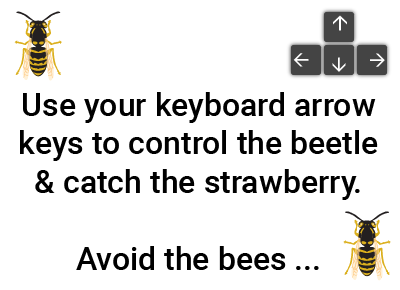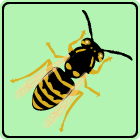


You got
| time | - | (health ÷ 10) | = | score | |
| 100 | - | (50 ÷ 10) | = | 127 |
3 scores max per player; No foul language, show respect for other players, etc.
Name | Score | Date | ||
|---|---|---|---|---|
| 1 | ||||
| 2 | ||||
| 3 | ||||
| 4 | ||||
| 5 | ||||
| 6 | ||||
| 7 | ||||
| 8 | ||||
| 9 | ||||
| 10 |

Game: THE BEETLE AND THE BEE
Aim: Collect the strawberries, avoid the bees
Method:
Move the beetle with the arrow keys or by tapping the screen. When the beetle catches the strawberry, you must answer the question. If you get it right you keep the strawberry and earn points.
Your final score is based on the time taken minus health lost divided by 10.

anonymous 🦄🦄🦄
"Angles on a straight line: missing angle"
The beetle and the bee game to practice
'Grouped frequency tables' for 7th grade
7th grade / Statistics / Continuous data / Continuous grouped data / Grouped frequency tables
Grouped frequency tables
Data in frequency tables can be discrete or continuous. Discrete data consists of single values, often whole numbers, and is how most data is initially gathered. If there are many data points to process, it becomes useful to group that data into a set of classes of continuous data. Continuous data can be represented in a "Grouped frequency table". Each class covers the data points within a certain range, and the classes together cover the entire range of all the data points. In grouped frequency tables, it is important that the classes cover the entire range of the given data while not overlapping.
The benefit of grouped frequency tables becomes clear when there are so many raw data points that discrete values would become difficult to process. A limitation of continuous data is that individual data points are lost so that exact calculations of the mode, median or range of the original discrete data points becomes impossible.
In this topic you are asked to compare each grouped frequency table to the raw data that it should represent. Many of the tables have deliberate mistakes that you must identify. You can do so by counting up the data points for each class and comparing them to the given frequencies.
In the first question, the raw discrete data points are:
10, 8, 25, 18, 15, 22, 5 ,9
The grouped frequency table splits the data into classes: 1-10, 11-20, 21-30.
The frequency for the 1-10 class is given as 4. We can look through the data points and confirm that there are indeed 4 values within this range: 10, 8, 5 and 9. So that frequency is correct. Checking the 2 other classes shows us that the table does indeed accurately represent the data, so the answer in this case is "yes, the table does match the data".
With our The beetle and the bee math game you will be practicing the topic "Grouped frequency tables" from 7th grade / Statistics / Continuous data / Continuous data. The math in this game consists of 16 questions that ask you to in each instance decide whether the grouped frequency table matches the raw data.

Fast moving interactive game to learn math where you control the beetle and the bee moves randomly about the screen. The bee should be avoided and the strawberries collected by answering math questions from the topic you have selected - this is learning math for fun!
Notes
- Fast moving game with character control via keyboard arrows.
- Suitable for tablets and mobiles by tapping the direction you want the beetle to go.
- Learn or revise your math and win strawberries for your beetle!
- On the second set of 5 levels there are 2 bees to avoid...
- It's a fun game, but it can be hard to get through to the end!
UXO * Duck shoot * The frog flies * Pong * Cat and mouse * The beetle and the bee
Rock fall * Four in a row * Sow grow * Choose or lose * Mix and match

Latest leaderboard entries: Beetle & bee




How to play The beetle and the bee to practice
'Grouped frequency tables' for 7th grade

The beetle is hungry and sees the tasty strawberry but the angry bee wants to sting it...
- Choose "The beetle and the bee" from the games selection page.
- When you start the game you are in the first level of a simple maze.
- You are the beetle and you want to eat the strawberry but there is a bee who will try to sting you.
- Each time the bee stings you, you lose a little of your life.
- Use your keyboard's arrows or tap the screen to move the beetle.
- Move the beetle around the obstacles avoiding the bee and get to the strawberry.
- When you catch a strawberry, you will get a math question from your selected topic.
- Select or enter the correct answer.
- If you are right you win the strawberry - now you must get back to the swirly "portal" at the top right of the screen.
- Entering the portal takes you to the next level of the maze.
- The game gets harder after the first 5 levels - now there are 2 bees trying to sting you...
- You need to complete all the levels without dying of bee stings to win.
- Your final score is your time taken minus your remaining health divided by 10.










